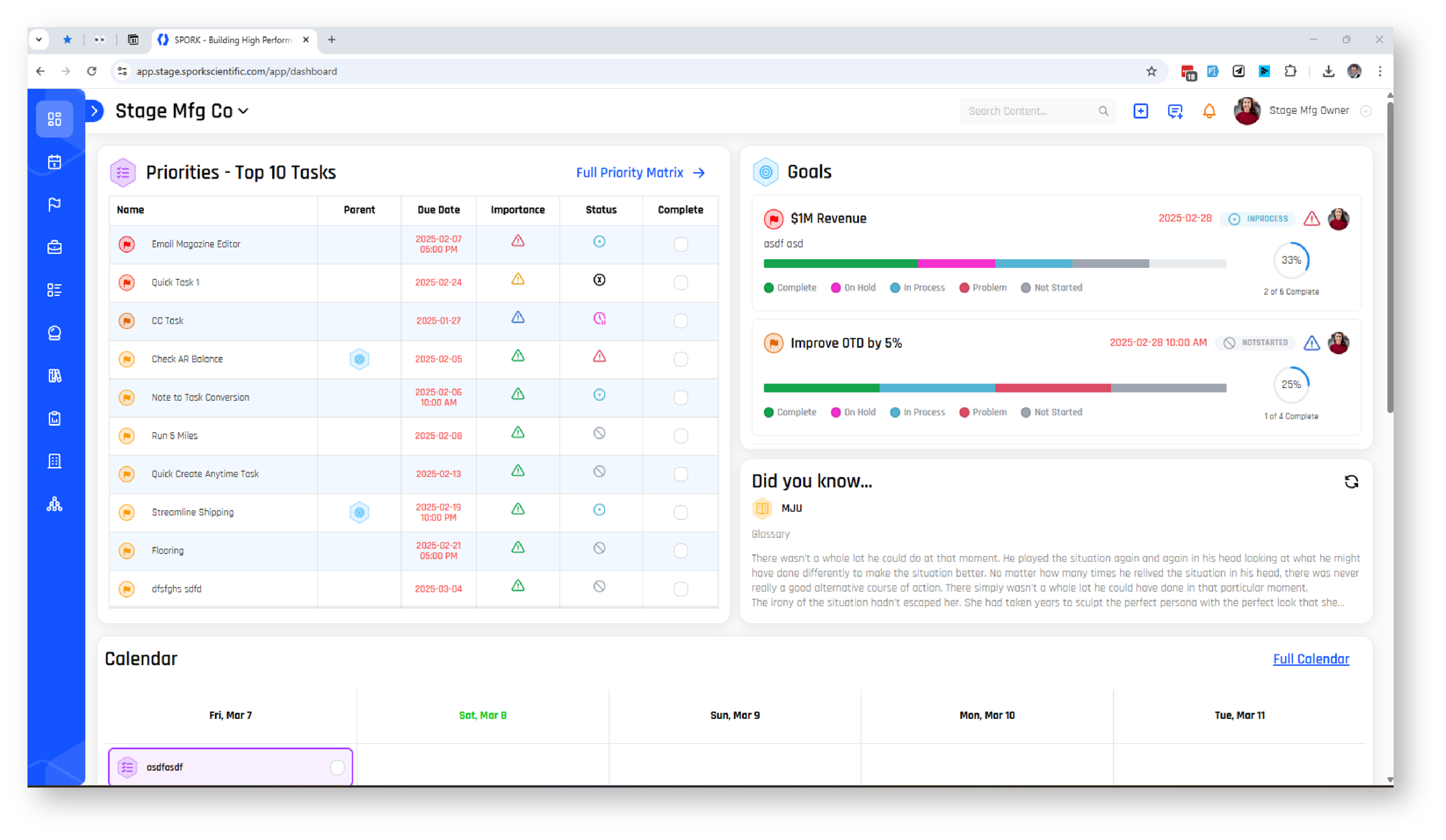Business Operating System - BOS

WHAT IS Business Operating System?
Breakdown of Business Operating System Key Components & Purpose
Purpose:
- Align leaders, teams, and strategy in one unified system.
- Eliminate chaos by replacing disconnected tools and meetings with a single source of truth.
- Create a consistent operating rhythm that drives focus and execution.
- Empower teams with clarity, accountability, and measurable progress.
- Enable organizations to scale intelligently and adapt with confidence.
Key Components:
- Strategy Hub: Define and communicate clear priorities and objectives across the organization.
- Alignment Engine: Cascade goals and responsibilities so every team knows what matters and why.
- Execution Tracker: Monitor progress, identify blockers, and drive accountability in real time.
- Leadership Dashboard: Give executives total visibility into performance, momentum, and alignment.
Benefits:
- Faster, more focused execution across the entire business.
- Increased accountability and ownership at every level.
- Greater clarity around priorities, goals, and results.
- Reduced friction, silos, and wasted motion.
- A leadership team that operates in sync — with a rhythm that scales.
Business without a BOS
Everything Feels Reactive
Without a system, the company spends most of its time putting out fires. Decisions are made on gut instinct, not data. Problems get fixed when they explode, not when they're just starting to simmer. It’s like playing whack-a-mole on hard mode—exhausting and chaotic.
No One Knows What Winning Looks Like
People are busy, sure. But busy doing what? Without clear goals and aligned priorities, teams drift. Everyone’s rowing, but often in different directions. That leads to duplicated efforts, missed opportunities, and a whole lot of “Wasn’t someone else doing that?”
Accountability Gets Murky
When there's no clear structure, expectations get fuzzy. Meetings become circular, projects stall, and fingers start pointing. A solid operating system brings clarity—who owns what, by when, and why it matters. Without that? It’s just vibes.
Culture Becomes Accidental
In the absence of intentional systems, culture becomes a byproduct of the loudest voices or the path of least resistance. That might work for a while, but it rarely scales. A structured system shapes a culture of discipline, alignment, and trust.
Growth Hits a Wall
At some point, the lack of structure becomes a ceiling. What got the company to $1M won’t get it to $10M, let alone $100M. Without a system to scale decision-making, performance tracking, and execution, the growth curve starts to flatten - and fast.
BOS Purpose
Drive Efficiency and Productivity
A BOS streamlines operations by documenting internal processes and creating consistency in how tasks are performed. This reduces inefficiencies, eliminates redundancies, and ensures smoother workflows.
Align Teams and Goals
It aligns and unifies teams with the company’s long-term strategic goals. By fostering clear communication, shared values, and a common vision, it ensures that all employees are working toward the same strategic objectives.
Improve Accountability
By defining roles, responsibilities, and measurable goals, a BOS establishes clear expectations for employees. This improves accountability across the organization and helps track progress effectively.
Supporting Scalability
A BOS provides the structure necessary for businesses to scale efficiently by standardizing operations and ensuring that processes can grow with the company.
Enhancing Company Culture
It promotes a positive work environment by respecting employees' time, recognizing their contributions, and fostering collaboration. This can improve employee retention and satisfaction.
What Is a Business Operating System (BOS)?
The High Cost of Operating Without a Business Operating System
- Lack of alignment: Teams are working hard, but not necessarily on the right things. Priorities are interpreted differently across departments. The right hand doesn’t know what the left is doing.
- The strategy-execution gap: Big goals are set, but they rarely trickle down into daily execution. Progress is assumed, not measured. Urgency replaces purpose.
- Siloed and disjointed systems: One team uses spreadsheets, another uses a project tracker, and leadership uses slides. It’s nearly impossible to see the big picture — let alone course correct in real time.
- Friction-filled meetings: Weekly meetings get dominated by status updates and rehashing past issues because there’s no shared context. Action is slow. Accountability is diffuse.
- Leadership drag: Executives spend more time chasing information than making decisions. This creates a culture of firefighting rather than focused execution.
Why SPORK Is the Business Operating System You Need
From Siloed to Synchronized
With SPORK, every team, goal, and initiative lives in the same system. Your leadership team no longer needs to piece together performance updates from disconnected tools — you see how everything fits together in real time.
From Gut Feel to Data-Driven Decisions
SPORK’s dashboards surface real progress, not vanity metrics. You’ll see what’s moving, what’s stuck, and what’s trending — so you can act early, not after the fact.
From Reactive to Proactive Leadership
Because SPORK builds a consistent rhythm into your weekly, monthly, and quarterly meetings, your leadership team spends less time looking backward and more time steering the business forward.
From Busywork to Purpose-Driven Work
Everyone in the organization understands the “why” behind their work. When goals are aligned and progress is transparent, people stop chasing tasks and start driving outcomes.
From Culture by Default to Culture by Design
SPORK fosters a culture of ownership, accountability, and continuous improvement. When teams are aligned and empowered, performance becomes a shared responsibility — not just a top-down demand.